Shengchao Chen
FeDaL: Federated Dataset Learning for Time Series Foundation Models
Aug 06, 2025Abstract:Dataset-wise heterogeneity introduces significant domain biases that fundamentally degrade generalization on Time Series Foundation Models (TSFMs), yet this challenge remains underexplored. This paper rethink the development of TSFMs using the paradigm of federated learning. We propose a novel Federated Dataset Learning (FeDaL) approach to tackle heterogeneous time series by learning dataset-agnostic temporal representations. Specifically, the distributed architecture of federated learning is a nature solution to decompose heterogeneous TS datasets into shared generalized knowledge and preserved personalized knowledge. Moreover, based on the TSFM architecture, FeDaL explicitly mitigates both local and global biases by adding two complementary mechanisms: Domain Bias Elimination (DBE) and Global Bias Elimination (GBE). FeDaL`s cross-dataset generalization has been extensively evaluated in real-world datasets spanning eight tasks, including both representation learning and downstream time series analysis, against 54 baselines. We further analyze federated scaling behavior, showing how data volume, client count, and join rate affect model performance under decentralization.
Boosting Sclera Segmentation through Semi-supervised Learning with Fewer Labels
Jan 13, 2025

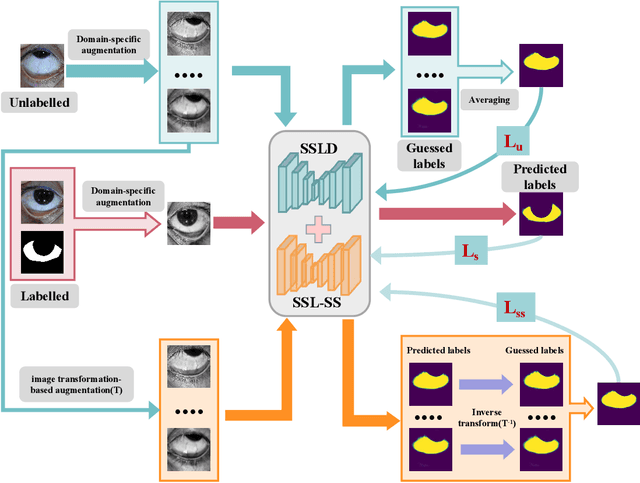
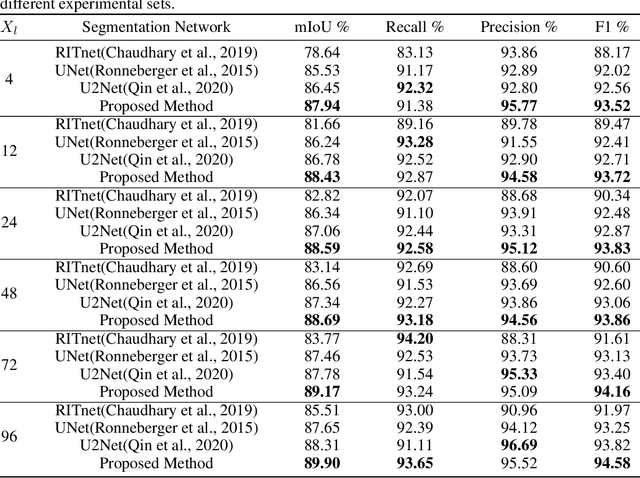
Abstract:Sclera segmentation is crucial for developing automatic eye-related medical computer-aided diagnostic systems, as well as for personal identification and verification, because the sclera contains distinct personal features. Deep learning-based sclera segmentation has achieved significant success compared to traditional methods that rely on hand-crafted features, primarily because it can autonomously extract critical output-related features without the need to consider potential physical constraints. However, achieving accurate sclera segmentation using these methods is challenging due to the scarcity of high-quality, fully labeled datasets, which depend on costly, labor-intensive medical acquisition and expertise. To address this challenge, this paper introduces a novel sclera segmentation framework that excels with limited labeled samples. Specifically, we employ a semi-supervised learning method that integrates domain-specific improvements and image-based spatial transformations to enhance segmentation performance. Additionally, we have developed a real-world eye diagnosis dataset to enrich the evaluation process. Extensive experiments on our dataset and two additional public datasets demonstrate the effectiveness and superiority of our proposed method, especially with significantly fewer labeled samples.
Federated Foundation Models on Heterogeneous Time Series
Dec 12, 2024Abstract:Training a general-purpose time series foundation models with robust generalization capabilities across diverse applications from scratch is still an open challenge. Efforts are primarily focused on fusing cross-domain time series datasets to extract shared subsequences as tokens for training models on Transformer architecture. However, due to significant statistical heterogeneity across domains, this cross-domain fusing approach doesn't work effectively as the same as fusing texts and images. To tackle this challenge, this paper proposes a novel federated learning approach to address the heterogeneity in time series foundation models training, namely FFTS. Specifically, each data-holding organization is treated as an independent client in a collaborative learning framework with federated settings, and then many client-specific local models will be trained to preserve the unique characteristics per dataset. Moreover, a new regularization mechanism will be applied to both client-side and server-side, thus to align the shared knowledge across heterogeneous datasets from different domains. Extensive experiments on benchmark datasets demonstrate the effectiveness of the proposed federated learning approach. The newly learned time series foundation models achieve superior generalization capabilities on cross-domain time series analysis tasks, including forecasting, imputation, and anomaly detection.
Federated Distillation for Medical Image Classification: Towards Trustworthy Computer-Aided Diagnosis
Jul 03, 2024Abstract:Medical image classification plays a crucial role in computer-aided clinical diagnosis. While deep learning techniques have significantly enhanced efficiency and reduced costs, the privacy-sensitive nature of medical imaging data complicates centralized storage and model training. Furthermore, low-resource healthcare organizations face challenges related to communication overhead and efficiency due to increasing data and model scales. This paper proposes a novel privacy-preserving medical image classification framework based on federated learning to address these issues, named FedMIC. The framework enables healthcare organizations to learn from both global and local knowledge, enhancing local representation of private data despite statistical heterogeneity. It provides customized models for organizations with diverse data distributions while minimizing communication overhead and improving efficiency without compromising performance. Our FedMIC enhances robustness and practical applicability under resource-constrained conditions. We demonstrate FedMIC's effectiveness using four public medical image datasets for classical medical image classification tasks.
Personalized Adapter for Large Meteorology Model on Devices: Towards Weather Foundation Models
May 24, 2024Abstract:This paper demonstrates that pre-trained language models (PLMs) are strong foundation models for on-device meteorological variables modeling. We present LM-Weather, a generic approach to taming PLMs, that have learned massive sequential knowledge from the universe of natural language databases, to acquire an immediate capability to obtain highly customized models for heterogeneous meteorological data on devices while keeping high efficiency. Concretely, we introduce a lightweight personalized adapter into PLMs and endows it with weather pattern awareness. During communication between clients and the server, low-rank-based transmission is performed to effectively fuse the global knowledge among devices while maintaining high communication efficiency and ensuring privacy. Experiments on real-wold dataset show that LM-Weather outperforms the state-of-the-art results by a large margin across various tasks (e.g., forecasting and imputation at different scales). We provide extensive and in-depth analyses experiments, which verify that LM-Weather can (1) indeed leverage sequential knowledge from natural language to accurately handle meteorological sequence, (2) allows each devices obtain highly customized models under significant heterogeneity, and (3) generalize under data-limited and out-of-distribution (OOD) scenarios.
Less is more: Ensemble Learning for Retinal Disease Recognition Under Limited Resources
Feb 15, 2024Abstract:Retinal optical coherence tomography (OCT) images provide crucial insights into the health of the posterior ocular segment. Therefore, the advancement of automated image analysis methods is imperative to equip clinicians and researchers with quantitative data, thereby facilitating informed decision-making. The application of deep learning (DL)-based approaches has gained extensive traction for executing these analysis tasks, demonstrating remarkable performance compared to labor-intensive manual analyses. However, the acquisition of Retinal OCT images often presents challenges stemming from privacy concerns and the resource-intensive labeling procedures, which contradicts the prevailing notion that DL models necessitate substantial data volumes for achieving superior performance. Moreover, limitations in available computational resources constrain the progress of high-performance medical artificial intelligence, particularly in less developed regions and countries. This paper introduces a novel ensemble learning mechanism designed for recognizing retinal diseases under limited resources (e.g., data, computation). The mechanism leverages insights from multiple pre-trained models, facilitating the transfer and adaptation of their knowledge to Retinal OCT images. This approach establishes a robust model even when confronted with limited labeled data, eliminating the need for an extensive array of parameters, as required in learning from scratch. Comprehensive experimentation on real-world datasets demonstrates that the proposed approach can achieve superior performance in recognizing Retinal OCT images, even when dealing with exceedingly restricted labeled datasets. Furthermore, this method obviates the necessity of learning extensive-scale parameters, making it well-suited for deployment in low-resource scenarios.
Free Lunch for Federated Remote Sensing Target Fine-Grained Classification: A Parameter-Efficient Framework
Jan 03, 2024Abstract:Remote Sensing Target Fine-grained Classification (TFGC) is of great significance in both military and civilian fields. Due to location differences, growth in data size, and centralized server storage constraints, these data are usually stored under different databases across regions/countries. However, privacy laws and national security concerns constrain researchers from accessing these sensitive remote sensing images for further analysis. Additionally, low-resource remote sensing devices encounter challenges in terms of communication overhead and efficiency when dealing with the ever-increasing data and model scales. To solve the above challenges, this paper proposes a novel Privacy-Reserving TFGC Framework based on Federated Learning, dubbed PRFL. The proposed framework allows each client to learn global and local knowledge to enhance the local representation of private data in environments with extreme statistical heterogeneity (non. Independent and Identically Distributed, IID). Thus, it provides highly customized models to clients with differentiated data distributions. Moreover, the framework minimizes communication overhead and improves efficiency while ensuring satisfactory performance, thereby enhancing robustness and practical applicability under resource-scarce conditions. We demonstrate the effectiveness of the proposed PRFL on the classical TFGC task by leveraging four public datasets.
Foundation Models for Weather and Climate Data Understanding: A Comprehensive Survey
Dec 05, 2023Abstract:As artificial intelligence (AI) continues to rapidly evolve, the realm of Earth and atmospheric sciences is increasingly adopting data-driven models, powered by progressive developments in deep learning (DL). Specifically, DL techniques are extensively utilized to decode the chaotic and nonlinear aspects of Earth systems, and to address climate challenges via understanding weather and climate data. Cutting-edge performance on specific tasks within narrower spatio-temporal scales has been achieved recently through DL. The rise of large models, specifically large language models (LLMs), has enabled fine-tuning processes that yield remarkable outcomes across various downstream tasks, thereby propelling the advancement of general AI. However, we are still navigating the initial stages of crafting general AI for weather and climate. In this survey, we offer an exhaustive, timely overview of state-of-the-art AI methodologies specifically engineered for weather and climate data, with a special focus on time series and text data. Our primary coverage encompasses four critical aspects: types of weather and climate data, principal model architectures, model scopes and applications, and datasets for weather and climate. Furthermore, in relation to the creation and application of foundation models for weather and climate data understanding, we delve into the field's prevailing challenges, offer crucial insights, and propose detailed avenues for future research. This comprehensive approach equips practitioners with the requisite knowledge to make substantial progress in this domain. Our survey encapsulates the most recent breakthroughs in research on large, data-driven models for weather and climate data understanding, emphasizing robust foundations, current advancements, practical applications, crucial resources, and prospective research opportunities.
Spatial-temporal Prompt Learning for Federated Weather Forecasting
May 23, 2023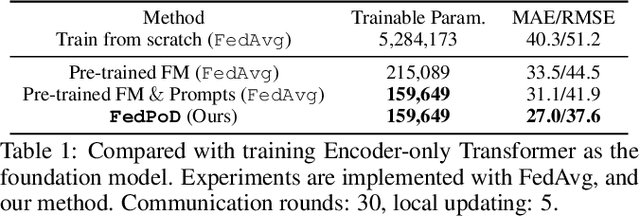
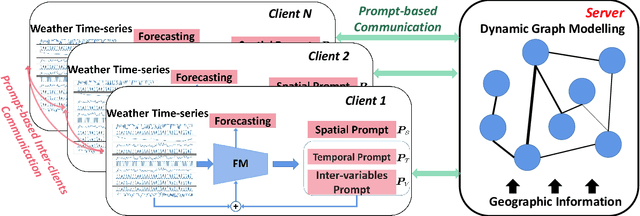
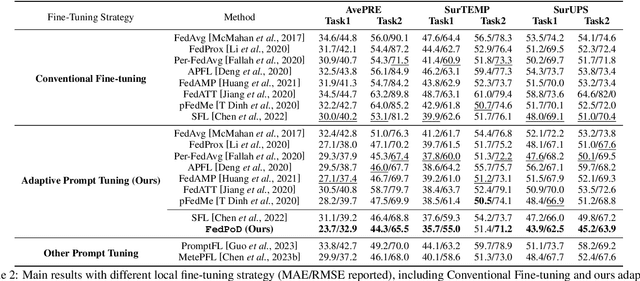
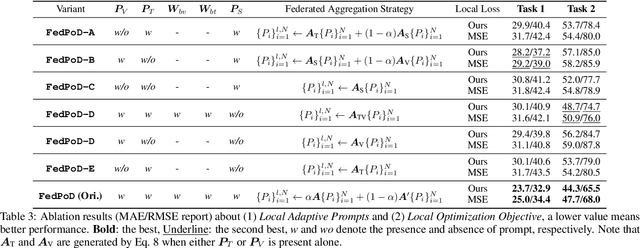
Abstract:Federated weather forecasting is a promising collaborative learning framework for analyzing meteorological data across participants from different countries and regions, thus embodying a global-scale real-time weather data predictive analytics platform to tackle climate change. This paper is to model the meteorological data in a federated setting where many distributed low-resourced sensors are deployed in different locations. Specifically, we model the spatial-temporal weather data into a federated prompt learning framework that leverages lightweight prompts to share meaningful representation and structural knowledge among participants. Prompts-based communication allows the server to establish the structural topology relationships among participants and further explore the complex spatial-temporal correlations without transmitting private data while mitigating communication overhead. Moreover, in addition to a globally shared large model at the server, our proposed method enables each participant to acquire a personalized model that is highly customized to tackle climate changes in a specific geographic area. We have demonstrated the effectiveness of our method on classical weather forecasting tasks by utilizing three spatial-temporal multivariate time-series weather data.
MASK-CNN-Transformer For Real-Time Multi-Label Weather Recognition
Apr 28, 2023Abstract:Weather recognition is an essential support for many practical life applications, including traffic safety, environment, and meteorology. However, many existing related works cannot comprehensively describe weather conditions due to their complex co-occurrence dependencies. This paper proposes a novel multi-label weather recognition model considering these dependencies. The proposed model called MASK-Convolutional Neural Network-Transformer (MASK-CT) is based on the Transformer, the convolutional process, and the MASK mechanism. The model employs multiple convolutional layers to extract features from weather images and a Transformer encoder to calculate the probability of each weather condition based on the extracted features. To improve the generalization ability of MASK-CT, a MASK mechanism is used during the training phase. The effect of the MASK mechanism is explored and discussed. The Mask mechanism randomly withholds some information from one-pair training instances (one image and its corresponding label). There are two types of MASK methods. Specifically, MASK-I is designed and deployed on the image before feeding it into the weather feature extractor and MASK-II is applied to the image label. The Transformer encoder is then utilized on the randomly masked image features and labels. The experimental results from various real-world weather recognition datasets demonstrate that the proposed MASK-CT model outperforms state-of-the-art methods. Furthermore, the high-speed dynamic real-time weather recognition capability of the MASK-CT is evaluated.
 Add to Chrome
Add to Chrome Add to Firefox
Add to Firefox Add to Edge
Add to Edge